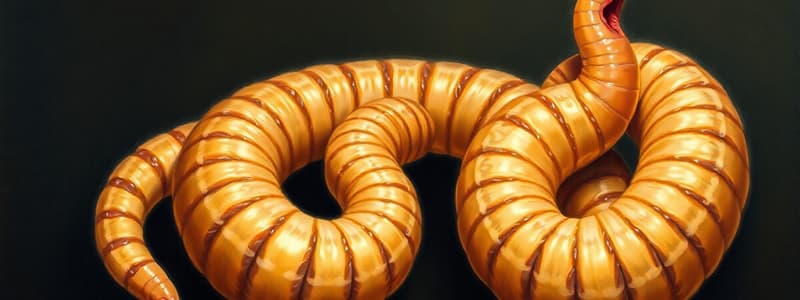Podcast
Questions and Answers
What is the primary organism responsible for elephantiasis?
What is the primary organism responsible for elephantiasis?
- Schistosoma species
- Ivermectin
- Cercariae
- Wuchereria bancrofti (correct)
What symptom is commonly associated with schistosomiasis?
What symptom is commonly associated with schistosomiasis?
- Swelling of limbs
- Fever (correct)
- Abdominal swelling
- Skin ulceration
Which treatment is effective for schistosomiasis?
Which treatment is effective for schistosomiasis?
- Praziquantel (correct)
- Ivermectin
- Mebendazole
- Diethylcarbamazine
How is elephantiasis primarily transmitted?
How is elephantiasis primarily transmitted?
What type of infections does mebendazole primarily treat?
What type of infections does mebendazole primarily treat?
In which geographical areas is schistosomiasis most commonly found?
In which geographical areas is schistosomiasis most commonly found?
What type of agent is avermectin considered to be?
What type of agent is avermectin considered to be?
Which of the following statements about lymphatic filariasis is false?
Which of the following statements about lymphatic filariasis is false?
What is the primary symptom of elephantiasis?
What is the primary symptom of elephantiasis?
Which antihelminthic agent is specifically used for treating filarial infections?
Which antihelminthic agent is specifically used for treating filarial infections?
What characteristic distinguishes Cestoda from Trematoda?
What characteristic distinguishes Cestoda from Trematoda?
Which of the following is a symtom associated with Pinworm Disease?
Which of the following is a symtom associated with Pinworm Disease?
How is Trichinellosis primarily transmitted?
How is Trichinellosis primarily transmitted?
What is the larval stage called in the nematode life cycle that can infect the host's body?
What is the larval stage called in the nematode life cycle that can infect the host's body?
What does the scolex of a tapeworm primarily function as?
What does the scolex of a tapeworm primarily function as?
Which organism is responsible for Ascariasis?
Which organism is responsible for Ascariasis?
In which geographical area is Necatoriasis most commonly found?
In which geographical area is Necatoriasis most commonly found?
What structure is involved in the transmission of disease in Trematoda?
What structure is involved in the transmission of disease in Trematoda?
What is the primary treatment for hookworm infection?
What is the primary treatment for hookworm infection?
What is unique about the digestive system of flatworms in general?
What is unique about the digestive system of flatworms in general?
Flashcards
What are Helminths?
What are Helminths?
Parasitic worms living in the body of their host, causing diseases.
What are Roundworms?
What are Roundworms?
They are cylindrical, unsegmented, and have a complete digestive system.
What are Flatworms?
What are Flatworms?
They are flat, soft-bodied, often segmented, and have no digestive system. Instead, they absorb nutrients through their skin.
What are Trematodes?
What are Trematodes?
Signup and view all the flashcards
What are Cestodes?
What are Cestodes?
Signup and view all the flashcards
What are Proglottids?
What are Proglottids?
Signup and view all the flashcards
What is a Scolex?
What is a Scolex?
Signup and view all the flashcards
What are Miracidia?
What are Miracidia?
Signup and view all the flashcards
What is the Rhabditiform stage?
What is the Rhabditiform stage?
Signup and view all the flashcards
What is the Filariform stage?
What is the Filariform stage?
Signup and view all the flashcards
Wuchereria bancrofti
Wuchereria bancrofti
Signup and view all the flashcards
Elephantiasis (Lymphatic Filariasis)
Elephantiasis (Lymphatic Filariasis)
Signup and view all the flashcards
Schistosoma species
Schistosoma species
Signup and view all the flashcards
Schistosomiasis
Schistosomiasis
Signup and view all the flashcards
Praziquantel
Praziquantel
Signup and view all the flashcards
Mebendazole
Mebendazole
Signup and view all the flashcards
Ivermectin
Ivermectin
Signup and view all the flashcards
Avermectin
Avermectin
Signup and view all the flashcards
Mosquito bite
Mosquito bite
Signup and view all the flashcards
Contact with contaminated water
Contact with contaminated water
Signup and view all the flashcards
Study Notes
Helminths: Parasitic Worms
- Helminths are parasitic worms living in a host, often causing disease.
- Two main classes: roundworms (nematodes) and flatworms (platyhelminthes).
Roundworms (Nematodes)
- Cylindrical, unsegmented worms.
- Possess a complete digestive system.
Flatworms (Platyhelminthes)
- Flat, soft-bodied worms.
- Often segmented.
- Lack a digestive system; absorb nutrients through their skin.
- Two subclasses: trematodes (flukes) and cestodes (tapeworms).
Trematodes (Flukes)
- Flattened, leaf-shaped.
- Nonsegmented.
- Have a mouth and suckers for attachment.
- Common transmission method: walking in infected water.
- Cause diseases like Schistosomiasis.
Cestodes (Tapeworms)
- Long, segmented bodies.
- Segmented.
- Lack a mouth; absorb nutrients through their body surface.
- Common transmission method: consuming undercooked meat.
- Cause diseases like tapeworm infection.
Cestode Structures
- Proglottids: Segments containing reproductive organs.
- Scolex: The head, equipped with suckers/hooks for attachment to the host's intestine.
Trematode Life Cycle
- Miracidium: Free-swimming larva that infects the first host (snail).
- Cercaria: Develops in the snail and infects the human host.
Nematode Life Cycle
- Rhabditiform: Larval stage in the host's digestive system.
- Filariform: Infective larval stage that penetrates the host's body.
Helminth Diseases
- Pinworm Disease (Enterobius vermicularis):
- Transmission: Ingesting pinworm eggs from contaminated surfaces.
- Symptoms: Itchy anus, irritability in children.
- Treatment: Mebendazole, albendazole.
- Trichinellosis (Trichinella spiralis):
- Transmission: Eating undercooked pork or wild game.
- Symptoms: Abdominal pain, muscle pain, fever.
- Treatment: Mebendazole, albendazole.
- Ascariasis (Ascaris lumbricoides):
- Transmission: Ingesting contaminated soil or food.
- Symptoms: Abdominal pain, coughing, malnutrition.
- Treatment: Mebendazole, albendazole.
- Necatoriasis/Hookworm (Necator americanus):
- Transmission: Skin contact with contaminated soil.
- Symptoms: Itchy rash, abdominal pain, anemia.
- Treatment: Mebendazole, albendazole.
- Elephantiasis (Lymphatic Filariasis, Wuchereria bancrofti):
- Transmission: Mosquito bite.
- Symptoms: Swelling of limbs, genital organs.
- Treatment: Ivermectin, diethylcarbamazine.
- Schistosomiasis (Schistosoma species):
- Transmission: Contact with contaminated water (cercariae penetrate skin).
- Symptoms: Fever, abdominal pain, blood in urine/stool.
- Treatment: Praziquantel.
Antihelminth Agents
- Praziquantel: Treats trematode and cestode infections.
- Mebendazole: Treats roundworm infections (e.g., pinworms, hookworms).
- Avermectin: Used for nematode infections & ectoparasites.
- Ivermectin: Treats filarial infections (e.g., elephantiasis) & other nematode infections.
Studying That Suits You
Use AI to generate personalized quizzes and flashcards to suit your learning preferences.
Description
Explore the fascinating world of helminths, the parasitic worms that can cause various diseases in their hosts. This quiz covers the two main classes of helminths: roundworms (nematodes) and flatworms (platyhelminthes), along with their structures and transmission methods. Test your knowledge on these vital organisms!




